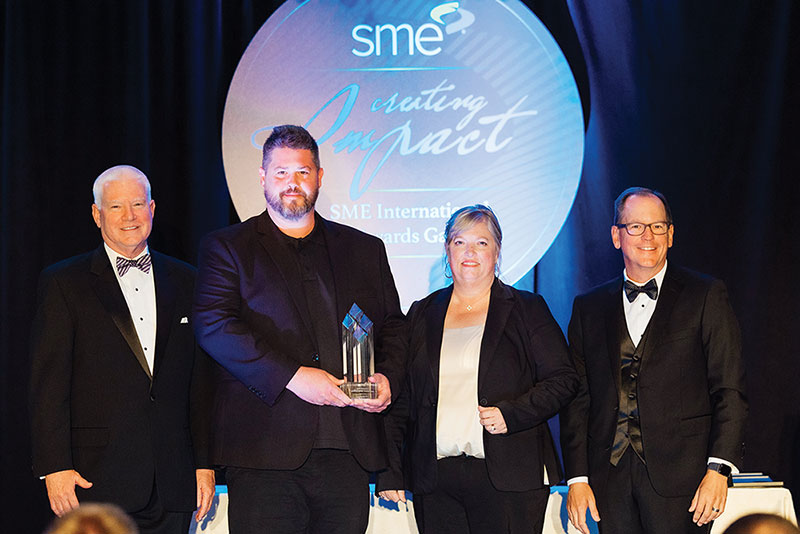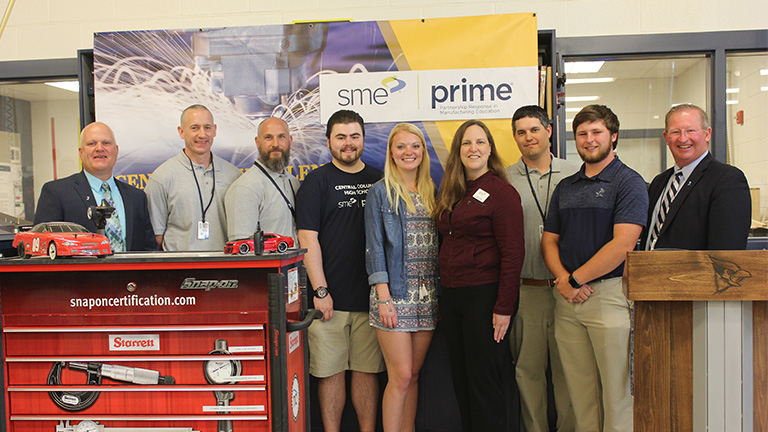Filling the Manufacturing Talent Gap
There currently are about 600,000 unfilled manufacturing jobs in the United States and the total is expected to balloon to 2.1 million by 2030, according to a recent study by the Manufacturing Institute. Filling the Manufacturing Talent Gap.
At the same time, many workers don’t have the skills needed to adapt to new technologies, and, in some cases, new candidates are ill-prepared to perform basic traditional manufacturing jobs. This makes finding and retaining skilled talent—both on the plant floor and in technical and engineering positions—a top priority and challenge.
Once hired, quality training is critical—people want to be trained both for the job they hold today and the position they aspire to in the future. As for benefits, workers want more pay, more vacation and flexible schedules—and they want to feel empowered in terms of leadership and advancement.
Similar issues also plague other industries, which only compounds the problem for manufacturers.
“Everybody is looking for talent,” says Jeannine Kunz, chief workforce development officer at SME. “It’s become competitive to find people. I don’t think there’s a sector in the United States that’s not struggling for qualified talent.”
As a result, she says, manufacturers must think through their value proposition and talent strategies to make themselves an “employer of choice.”
With more jobs than people capable of working, applicants feel they can afford to be choosy and may even skip interviews. To combat the situation, manufacturers are adopting new and creative recruiting, training and retention programs to build and maintain tomorrow’s workforce.
Overcoming Challenges
“The biggest challenge we face as manufacturers is supply and demand for experienced engineering/IT talent,” attests Mike Russ, talent acquisition manager at Toyota Material Handling Inc. (TMH), a Columbus, Ind.-based subsidiary of Toyota Industries Corp.
Noting that many industries are looking for the same technical talent, he says there are more job openings than qualified candidates, especially in the Midwest. As a result, TMH often expands its search to the east and west coasts. This leads to another obstacle, however, as the company struggles to find candidates willing to relocate and work onsite.
“Right now, there are two jobs out there for every available worker in the marketplace,” adds Jackie Morgan, vice president of global talent acquisition at Eaton Corp. “Such intense supply and demand means candidates can often receive multiple offers at the same time, making it an especially competitive environment for employers. Moreover, demographic trends, such as lower birth rates and fewer people entering the workplace, are also contributing to a structural problem that’s not likely to change in the foreseeable future.”
Workforce Choices
One of the biggest challenges is how people view work since the pandemic. “The world of work became one of wide-open choices for prospective employees,” says Nate Becker, training and development specialist at Intek Plastics LLC, Hastings, Minn. “If employees did not like something about a company, they would just move on to the next one. This led to a bidding war between employers with sign-on bonuses and benefit packages.
“What this meant for most manufacturers was that for every 10 interviews scheduled, maybe half of them showed up,” he continues. “Then, for those that were offered jobs, only a small percentage of them accepted because five other companies were sending them an offer at the same time.”
The shortage is critical in the automotive sector, adds Tracy Heath, smart manufacturing human capital leader and principal at Deloitte Consulting LLP. “Automotive struggles more with attracting new talent, as the industry has tended to historically favor the tenure of employees (e.g. ‘lifers’), which has limited how they’ve looked at backfilling retiring/aging workers; and the industry is more hierarchical.”
Bottom Line Impact
In a recent study, Deloitte and the Manufacturing Institute found that 83% of surveyed manufacturers cited attracting and retaining a quality workforce as their top challenge. With this comes substantial business implications:
- 45% of respondents said they turned down business opportunities because they lacked workers;
- 71% said the lack of talent negatively impacted timelines for product deliveries;
- 70% said it negatively impacted production process timelines; and
- 56% said it disrupted the delivery of key manufacturing input.
Two key drivers are the aging workforce and the skills gap, according to Jason Bergstrom, smart manufacturing senior commercial advisor and principal at Deloitte.
“As older generations continue leaving the workforce in droves, companies across sectors are forced to fill positions rapidly,” Bergstrom says. “Yet, at the same time, technology advancements are creating larger skills gap that cannot be filled effectively with the current applicant pool. This is because work today is no longer being performed just by employees. Increasingly, employees work with and beside intelligent machines, using automation as a component of workflow.

“Gone are the days when current employees and new hires could rely solely on prior experiences,” Bergstrom continues. “Now they are required to dive in and get as educated as possible on how best to use new technology and tools in their daily jobs.”
Star Treatment
In the past, Star Cutter Co., Farmington Hills, Mich., hired employees from farm families because those workers had a mechanical aptitude and were used to maintaining and repairing farm equipment, says Lindsey Bielby, human resources manager. But as the number of family-owned farms in the area has shrunk, so has the labor pool.
“We’re hiring people off the street and trying to get them into a manufacturing setting,” he says. “We’re training them in some highly technical positions and trying to get them past two years. We’re pulling from a talent pool that doesn’t necessarily exist.”
Manufacturers have to find ways to attract workers, SME’s Kunz stresses. “They also have to have a strategy for developing and retaining their workforce. People don’t want to stay in a workplace that does not demonstrate that people are a key part of their strategy going forward.”
Working overtime once was a clear pathway to more pay. That’s no longer clear cut.

“The current workforce may not be inclined to commit to a workweek with overtime—even with overtime pay,” Morgan says. “They simply will not sacrifice flexibility and a personal life for pay. To remain competitive, we must look at ways we can offer incentives beyond remote work options. They can include adapting a production schedule to be more conducive to work/life balance, offering more flexible shifts, investing in employee development and creating a positive workplace culture that gives back to the communities where we’re located.”
To help attract workers, Star Cutter significantly raised starting pay, Bielby says. The company also offers a $500 bonus to each new hire and a $250 bonus to the employees who referred that new hire. About 90% of employees participate, according to Mike Billiel, vice president of operations. “Instead of the plant manager and supervisors looking through piles of resumes, let’s let the people on the floor participate in the process,” Billiel says. “They know who they want to work with.”
Star Cutter also reduced deductibles by up to one half on its health insurance plans, increased its 401k match and offered money to offset gas and travel costs when gasoline prices were high. The company doubled vacation days offered to employees after one year—going from one week of PTO to two weeks—and significantly cut the time frame needed to reach four weeks of vacation.
Star Cutter also offered a pathway to more pay if employees met certain skills and performance benchmarks. “Employees can see there’s a carrot to learn more skills, to be more advanced in their skills from technology,” Billiel says.
The company had to tread carefully, though, to avoid alienating long-term workers who had worked through less vacation time and lower wages, acknowledges Jon Dreher, general manager of Star Cutter’s H.B. Carbide plant in Lewiston, Mich. To retain those workers, the company now offers up to $2 an hour more for longevity/loyalty and commitment/good attendance, he says.
Creating a Work-From-Home Environment—at Work
Toyota Material Handling offers a variety of family-friendly benefits, including generous parental leave, low-cost medical insurance and competitive time off, the company boasts.
“We focus on providing the best possible experience while they are working onsite with us,” Russ says. “Building a homelike atmosphere is an essential component of our culture and one of our core values.”
As part of that atmosphere, TMH offers a free, onsite recreational facility, onsite physical therapists and two cafeterias with free coffee.
Manufacturers also compete with employers in sectors where remote or hybrid work is a proven possibility, posing another challenge.

Intek Plastics, which won SME’s 2023 “Excellence in Manufacturing Training Award,” offers a variety of perks and incentives to keep employees happy. The list includes strong, paid time-off programs, a significant number of paid holidays and perfect attendance programs. These are “a few of the things we do that help to offset the flexibility of hybrid work for our production staff,” notes Sonya Prange, vice president of human resources and service operations.
Some manufacturers have switched from five eight-hour shifts to four 10-hour shifts to offer more flexibility, Kunz adds. Alternatively, a parent might prefer shifts that align with school hours, she says.
“It depends on the work and the worker,” Prange points out. “We have found that 10-hour days get long for our staff and the physical work they do.”
As alternatives, the company provides paid breaks and lunch, which Prange says basically results in a seven-hour day but being paid for eight. “We preload our paid time off when they start and each year annually, which provides more flexibility to take a vacation soon after starting versus having to wait for several weeks/months during the year.”
Setting Up Employees for Success
Training and employee development have become increasingly important. Intek started addressing these issues at what turned out to be the perfect time—just before the pandemic.
“We recognized the need for position-specific training to set up employees for not only success in their current roles, but also the roles they may want to move to in the future,” Becker says. “We began building what have now become multi-award winning programs on the foundation that we wanted to give people the kind of training and opportunities that we wish we would have had decades ago.”
A successful training strategy involves balancing on-the-job experiences (70%), classroom learning (10-20%) and project-based activities (10-20%), according to Eaton’s Morgan.
“Training presents a dual challenge of time and resources, and it’s compounded by the uncertainty of future skill requirements,” Morgan says. “The key question is, ‘How can we best identify and develop the skills we will need for tomorrow?’ One of our competitive advantages at Eaton is that we don’t just focus on training in hard skills, but essential soft skills that help employees evolve.”
Retention and training are becoming more closely linked, Morgan continues. “Retention traditionally stemmed from employee needs such as compensation, flexibility and work-life balance,” she explains. “However, recent studies indicate a growing desire for skill development and investment in growth. In manufacturing, we are also paying closer attention to overtime, which not all employees want. To be successful, we must value balance and growth, factor employee feedback into decision-making and continue listening to what employees are saying about our culture and work conditions so that we can continue making improvements.”
Measurable Results
Intek’s operators, team leads and supervisors worked together to design a training system for new hires’ first 90 days. “The system ensures training is repeatable, the progress is measurable and the results are consistent,” says Chris Von Helmst, training and development specialist.
Intek has a leveling system that enables operators to play a role in when they get skills-based pay increases, according to Von Helmst. “There are 10 levels total, and as long as an operator spends a minimum of two months within a level they can put in a request to test up,” he says. “If they pass their test, which is usually a timed setup, they increase in level and pay. Finally, we have robust apprenticeship and career path options that have resulted in production employees becoming supervisors, toolmakers, maintenance employees and more.”
At Star Cutter, one key change was in workplace leadership, Dreher says. In the past, one supervisor managed 50 employees. Now team/cell leaders lead six to eight employees, offering an early, clear path to advancement, more accountability and leadership closer to the line. “We want to employ a leader-leader mentality, not just leader-follower,” he says.
Toyota Material Handling offers numerous training opportunities from Excel basics to advanced leadership techniques. The company also partners with local universities to ensure it’s always offering the most robust and cutting-edge training initiatives, Russ says.
“The ideal partnership is collaboration on curriculum that aligns with our needs. This will ensure that students have the relevant skills needed in our manufacturing facility to be successful upon graduation.”
A Pipeline to Prosperity and Other PRIME Examples
In August 2023, SME launched the Workforce Pipeline Challenge (WPC), a three-year pilot program working with community colleges and technical schools to grow the industry’s talent pipeline and enhance the skills and productivity of manufacturing workers.

The goal is to attract 1,000 people per year at each of the initial 25 participating schools, which would yield 75,000 or more qualified workers in pursuit of manufacturing careers. In addition, best practices identified throughout the program will be shared nationally to help implement innovative solutions to grow local economies, reduce barriers to employment and fill vacant manufacturing jobs.
Workforce Pipeline Challenge
The Workforce Pipeline Challenge complements the 13-year-old SME PRIME (Partnership Response In Manufacturing Education), which teams private industry with educators to build custom manufacturing and engineering programs in high schools. More than 30 SME PRIME schools received financial awards from the SME Education Foundation to sustain manufacturing and engineering programs last year.
Under the new WPC initiative, SME will work with schools to conduct a labor analysis and develop strategies to attract new populations—especially those underserved and underrepresented in the workforce, and implement programs and certifications to develop skilled people who are ready to hire.
“Manufacturers have told us, ‘I really like what SME can do to help train and develop my workforce. I just need a workforce to train,’” says Jeannine Kunz, SME’s chief workforce development officer. “While developing their existing workforce is still a challenge, the greater task lately is attracting new talent. This led us to increase our efforts and focus on building a larger and qualified pipeline of talent across the United States, and, at the same time, strengthening the system to put people into the jobs of the future and reduce the supply and demand gap.”
Source: Filling the Manufacturing Talent Gap
https://www.smeef.org/prime-schools-initiative/sme-prime/
https://www.sme.org/technologies/articles/2024/february/filling-the-manufacturing-talent-gap/

